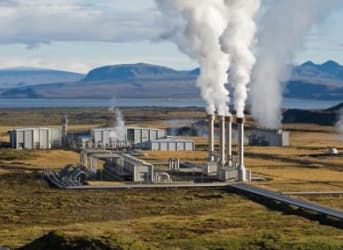The bubbling sulfur springs and powerful, majestic geysers of Yellowstone National Park are visible manifestations of the potential for geothermal energy in the United States.
Yet for various reasons -- including logistics, economics and permitting issues -- geothermal has not even come close to reaching its potential. That could be changing, though, with the introduction this summer of a series of geothermal bills that may hasten its development and remove some bureaucratic obstacles.
Renewable Energy World reported at the end of July that U.S. House and Senate subcommittees discussed permitting needs and took up two bills related to geothermal development.
The House subcommittee heard that an inordinate amount of red tape hampers geothermal in the U.S. For example, the National Environmental Policy Act (NEPA) requires geothermal developers to submit over 175 “document sets” for each project, which could mean hundreds of thousands of pages.
The subcommittee also learned that geothermal power projects can take as many as seven years to develop, compared to three to five years for oil and gas projects, and just 18 months for solar or wind start-ups.
The Geothermal Energy on Federal Lands Act would streamline the process to allow a geothermal project to move forward quickly if resources are found, while another proposed bill would promote the development of renewable energy on public lands.
Geothermal legislation is also moving forward at the state level. In California -- home to The Geysers, the world’s largest geothermal field -- a bill calls for the installation of 500 megawatts by 2024. A significant part of new geothermal capacity in California is expected to come from the Salton Sea initiative, a plan to develop geothermal power from under a manmade desert sea, creating 1,700 MW by 2032.
Meanwhile Nevada, another hotbed of U.S. geothermal, is looking to revamp its renewable portfolio standard after surpassing previous geothermal goals. The state also lets companies buy renewable energy directly from utilities. Apple’s data centers are now powered by geothermal and other renewables, according to a report in Renewable Energy World.
Related: U.S. Game Changing Renewable- Geothermal Power
The policy changes are welcome in the United States, where geothermal growth has lagged behind other parts of the world, such as East Africa and Turkey. While the U.S. has the highest number of projects underway -- 124 versus 63 in Indonesia, the closest competitor -- the 85 megawatts of new capacity added in 2013 was 40 percent less than in 2012.
Of course, the United States has a long way to go to catch Iceland, the world’s geothermal champion, where 66 percent of the island nation’s power comes from the earth’s heat.
Geothermal energy advocates say it is more reliable than solar and wind because it is not limited by the “intermittency” factor. While solar and wind require the sun to shine and the wind to blow, geothermal facilities provide a constant source of baseload power and can be brought online much quicker than, say, coal-fired plants, which require long and costly ramp-up times.
But geothermal faces other limitations, including geography. Geothermal power plants typically must be sited near accessible deposits of high-temperature groundwater. That has led to the development of enhanced geothermal systems (EGS), where underground steam reservoirs are created when water is injected deep into the ground. EGS systems are being tested all over the world, including at Cooper Basin in Australia, the world’s largest, but the technology is expensive.
Related: Drilling Down to the Economics of Geothermal Power
The economics of geothermal exploration can also be challenging. Drilling a geothermal well is a much riskier proposition than building a solar installation or wind farm, and the payouts are obviously much less than drilling for oil or natural gas. Mining.com recently published an interesting perspective on geothermal from Ross Beaty, a well-known and respected mining CEO who made a significant investment in geothermal in 2008.
ADVERTISEMENT
According to Beaty, while the potential of geothermal seems limitless, “After a couple of years and investment of about $150 million from my shareholders, I became quite disillusioned about the ability of geothermal power to be anything other than a bit player in the world energy equation. Reality triumphed over my idealism,” he wrote in an unpublished report.
Among its limitations, Beaty listed costly drilling due to the wide-diameter, kilometers-deep holes required to access high-temperature geothermal systems; complex fluids with variable chemistry; costly and difficult reinjection; flammable chemicals required to produce electricity; and the fact that geothermal systems are often located far from the electricity grid, requiring long and costly transmission lines.
But despite his conclusion that “commercial geothermal electricity production is an extremely tough and risky business,” geothermal appears set to finally take off in the U.S.
By Andrew Topf of Oilprice.com



















Iceland, which already has the electrical generation capacity could start phase 1 by producing the hydrogen. Then all you would need is a generator that runs off hydrogen, lets say start off in California which is lso suffering from drought.
How does everybody check in on the future of the fossil - coal - industry?